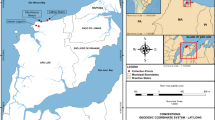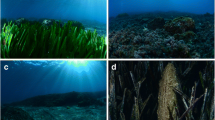Abstract
The Yatsushiro Sea is an inland sea in the southwestern part of Kyushu Island, covering an area of 1,200 km2, and is partly connected to the Ariake Sea to the north and the east China Sea to the south. The innermost part of the sea is semi-enclosed by the Shiranui reclaimed land, which was created in 1967. Coastal fishery operators in the region have suggested that fish stocks have declined due to the accumulation of ‘hedoro’ (sludge) on the sea floor, which increased after the land was reclaimed. This project analyzed spatiotemporal changes in the community structure of the meiofauna, which represent ideal organisms for environment assays and in the environmental factors in sediments at four fixed stations around the inner part of the northern Yatsushiro Sea over 3 years (May 2010–February 2013). The results confirm the site of local deposits in the narrow sub tidal section off the Shiranui reclaimed land, where rich organic matter has accumulated and highly sulfidic conditions above the standard criterion value for fisheries were present, along with clear and significant decreases in meiofaunal abundance during the summer. Multivariate analyses, however, did not reveal any strong association between the meiofaunal composition and any environmental factor in sediments, suggesting the organic and sulfidic conditions were not driving the temporal changes in meiofaunal structure in the area. Instead, the meiofaunal changes could be directly related to the low continuous decline in dissolved oxygen and salinity in the water on the sea floor in summer.






Similar content being viewed by others
References
Akimoto K, Takikawa K, Shimasaki H, Yamashita T, Matsunaga T, Nishimura K, Tanaka M, Hiraki K (2006) Distribution patterns of sediments in the north Yatsushiro Sea, Kyusyu, Japan. Kaiyo Mon 38:97–104 (in Japanese)
Anderson MJ, Gorley RN, Clarke KR (2008) PERMANOVA + for PRIMER: guide to software and statistical methods. Plymouth, PRIMER-E, p 214
Clarke KR, Warwick RM (2001) Change in marine communities: an approach to statistical analysis and interpretation, 2nd edn. Plymouth, PRIMER-E, p 162
Coull BC, Chandler GT (1992) Pollution and meiofauna: field, laboratory, and mesocosm studies. Oceanogr Mar Biol Ann Rev 30:191–271
Danovaro R (2010) Methods for the study of deep-sea sediments, their functioning and biodiversity. CRC Press, New York, p 428
De Troch M, Roelofs M, Riedel B, Grego M (2013) Structural and functional responses of harpacticoid copepods to anoxia in the northern Adriatic: an experimental approach. Biogeosciences 10:4259–4272
Giere O (2009) Meiobenthology. The microscopic motile fauna of aquatic sediments, vol 2. Universität Hamburg, Hamburg, p 527
Henmi Y (2005) Animals and plants in tidal flats of the Yatsushiro Sea. Kaiyo Mon 37:53–58 (in Japanese)
Hicks GRF, Coull BC (1983) The ecology of marine meiobenthic harpacticoid copepods. Oceanogr Mar Biol Ann Rev 21:67–175
Itaoka M, Tamai K (1993) Effect of eutrophication on the structure of meiobenthic communities in Hiroshima Bay. Benthos Res 45:19–28 (in Japanese with English abstract)
Japan Fisheries Resource Conservation Association (2005) Shisan Yousui Kijyun (Quality Standards for Fishery Water). http://ay.fish-jfrca.jp/kiban/kankyou/hourei/yousui/suisan_kijyun.html (in Japanese)
Kumamoto Port and Airport Construction Office, Kyusyu Regional Development Bureau, Ministry of Land, Infrastructure, Transport and Tourism (2012a) Heisei 22 Nendo Kankyo Seibi Sen “KAIKI” Nenji Houkokusyo (annual report of environment maintenance ship “KAIKI” in JPY 2010). Kumamoto Port and Airport Construction Office, Kumamoto, p 93 (in Japanese)
Kumamoto Port and Airport Construction Office, Kyusyu Regional Development Bureau, Ministry of Land, Infrastructure, Transport and Tourism (2012b) Heisei 23 Nendo Kankyo Seibi Sen “KAIKI” Nenji Houkokusyo (annual report of environment maintenance ship “KAIKI” in JPY 2011). Kumamoto Port and Airport Construction Office, Kumamoto, p 94 (in Japanese)
Kumamoto Port and Airport Construction Office, Kyusyu Regional Development Bureau, Ministry of Land, Infrastructure, Transport and Tourism (2013) Heisei 24 Nendo Kankyo Seibi Sen “KAIKI”, “KAIKO” Nenji Houkokusyo (annual report of environment maintenance ships “KAIKI” and “KAIKO” in JFY 2012). Kumamoto Port and Airport Construction Office, Kumamoto, p 123 (in Japanese)
Ohwada K (2005) Environmental and biological characteristics of the Yatsushiro Sea––Introduction. Kaiyo Mon 37:3–7 (in Japanese)
Ohwada K (2006) Environmental and biological characteristics of the Yatsushiro Sea-2 (Introduction). Kaiyo Mon 38:73–78 (in Japanese)
Sato M (ed) (2000) Ariakekai no Ikimono Tachi (Life in Ariake Sea). Kaiyusha, Tokyo, p 396 (in Japanese)
Sougawa H, Shimode S, Hashimoto T, Kikuchi T (2008) Potential use of meiobenthos and free-living nematodes for sediment quality assessment in Manazuru Port, Sagami Bay, Japan. Jpn J benthol 63:11–22 (in Japanese with English abstract)
Takikawa K, Tanaka K (2005) Characteristics of physical environments in Yatsushiro-Sea. Kaiyo Mon 37:12–18 (in Japanese)
The Committee for recovering tidal flats and other ecosystems in the Marine Coastal area in the Ariake and Yatsushiro Seas (2006) Ariake Kai Yatsushiro Kai Higata Nado Engan Kaiiki Saisei Kentou Iinkai Houkoku Syo (Report of the committee for recovering tidal flats and other ecosystems in the marine coastal area in the Ariake and Yatsushiro Seas). http://www.pref.kumamoto.jp/soshiki/48/higatasaisei.html (in Japanese)
Tsujino M, Uchida T (2011) Effects of a macroalgal mat (Ulva spp.) on the epibenthic meiofauna of an intertidal sand flat in Hiroshima Bay, western Japan. Jpn J Benthol 65:90–97 (in Japanese with English abstract)
Tsujino M, Arima S, Kamiyama T, Uchida T (2008) Biomass and production of macrobenthos and meiobenthos in Hiroshima Bay, Seto Inland Sea. Jpn J Benthol 63:35–41 (in Japanese with English abstract)
Tsutsumi H (2003) Fu-Eiyouka niyoru Kankyou Kakuran (Environmental disturbance caused by eutrophication). In: Wada K (ed) Ecology of Marine Benthos. Tokai University Press, Hatano, pp 407–444 (in Japanese)
Tsutsumi H (2006) Critical events in the Ariake Bay ecosystem: clam population collapse, red tides, and hypoxic bottom water. Plankton Benthos Res 1:3–25
Yoshino K, Katano T, Ito Y, Hamada T, Fujii N, Hayami Y (2014) Community assembly by limited recruitment in a hypoxia-stressed soft bottom: a case study of macrobenthos in Ariake Bay. Plankton Benthos Res 9:57–66
Acknowledgments
We thank Mr. Hideyuki Shimasaki, the captain of the research vessel “Dolphin II”, and the students at the Aitsu Marine Station, Kumamoto University, who helped with our sampling. Special thanks to two anonymous reviewers, who kindly checked our manuscript. This study was partly supported by “Enhancing various Academic Research Functions with using Characteristics of University Research” granted by the Ministry of Education, Sports, Culture, Science, and Technology of Japan (represented by Dr. Kiyoshi Takikawa).
Author information
Authors and Affiliations
Corresponding author
Rights and permissions
About this article
Cite this article
Shimanaga, M., Maenaka, A., Misonou, T. et al. Spatiotemporal changes in meiofaunal composition on soft substrates in the semi-enclosed inner section of the northern Yatsushiro Sea. J Oceanogr 71, 177–186 (2015). https://doi.org/10.1007/s10872-015-0274-8
Received:
Revised:
Accepted:
Published:
Issue Date:
DOI: https://doi.org/10.1007/s10872-015-0274-8




